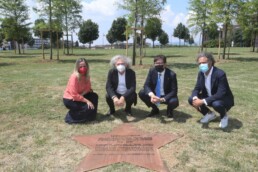La Stella di Dante, the environmental installation by Felice Limosani in San Donato Park
The work was donated by the Florentine fashion house, Il Bisonte

The work of art immersed in the San Donato Park in Novoli is a large star made up of 50 trees that at night give an even more enchanting show thanks to the lighting. The environmental installation was designed by Felice Limosani, with the scientific direction of Stefano Mancuso. 50 30-year-old oak-willow trees were selected, immediately creating a green oasis within the park. The work was created thanks to the contribution of the Florentine fashion house, Il Bisonte, which decided to share the celebrations for its 50th anniversary with the city.
Felice Limosani commented, “I interpreted Dante by transforming the recurring stars in the closing phrases of the three canticles of the Divine Comedy into an installation that’s a “living” form. Inspired by Dante, I experienced, in addition to the aesthetic function, the search for wider connections than the meanings that the Supreme Poet left us. In this historical moment, it’s a priority to create long-term value between art and the environment with people at the center”.
The work by Felice Limosani metaphorically translates the final sentences of the three canticles of the Divine Comedy into a symbol: “and then we went out to see the stars” – Inferno; “Pure and willing to rise to the stars” – Purgatory; “The love that moves the sun and the other stars” – Paradise.
Stefano Mancuso elaborated, “I imagine that if Dante wrote today, the forest would no longer be such a dark place and the celestial city would become green. This work by Felice Limosani reminds us that plants can change the future of our cities”.
A work of art that’s beneficial for the planet
The activities are carried out with the collaboration of the Pnat company, an academic group of the University of Florence, with landscape supervision by Alberto Giuntoli, professor at the University of Florence and CNR researcher. PNAT has calculated the benefits of planting the 50 oaks to the surrounding environment over the next 50 years.
An 18cm sized oak-willow that’s 30 years old will already be able to absorb about 29kg of Co2 per year, from its first year of being planted. In the tenth year of planting, thanks to the increase in the diameter of the stem and the crown, the same tree will be able to reduce about 50 kg of Co2 per year, up to 73kg in its twentieth year, and about 140kg of Co2 per year by its 50th year.
The Co2 stored by the 50 trees increases to 234 tons, 50 years after planting (plants that are 80 years old), producing an economic saving of about 10 thousand euros. This will help maintain soil permeability and improve the microclimate, also constituting an important reserve of biodiversity. The presence of wild turf will serve as a ‘call’ for pollinators, essential components of the urban ecosystem, capable of contributing to biodiversity and the functioning of green infrastructures.




